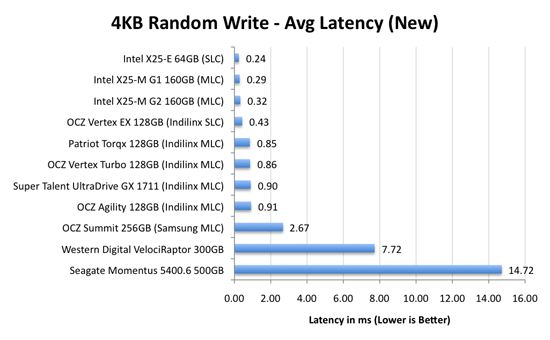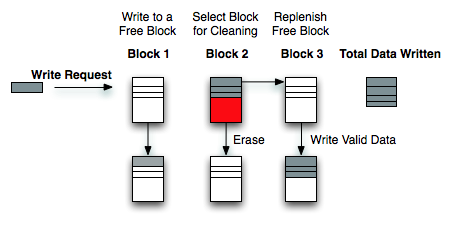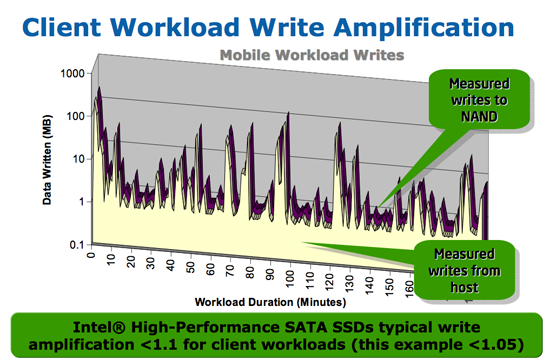The SSD Relapse: Understanding and Choosing the Best SSD
by Anand Lal Shimpi on August 30, 2009 12:00 AM EST- Posted in
- Storage
The Cleaning Lady and Write Amplification
Imagine you’re running a cafeteria. This is the real world and your cafeteria has a finite number of plates, say 200 for the entire cafeteria. Your cafeteria is open for dinner and over the course of the night you may serve a total of 1000 people. The number of guests outnumbers the total number of plates 5-to-1, thankfully they don’t all eat at once.
You’ve got a dishwasher who cleans the dirty dishes as the tables are bussed and then puts them in a pile of clean dishes for the servers to use as new diners arrive.
Pretty basic, right? That’s how an SSD works.
Remember the rules: you can read from and write to pages, but you must erase entire blocks at a time. If a block is full of invalid pages (files that have been overwritten at the file system level for example), it must be erased before it can be written to.
All SSDs have a dishwasher of sorts, except instead of cleaning dishes, its job is to clean NAND blocks and prep them for use. The cleaning algorithms don’t really kick in when the drive is new, but put a few days, weeks or months of use on the drive and cleaning will become a regular part of its routine.
Remember this picture?

It (roughly) describes what happens when you go to write a page of data to a block that’s full of both valid and invalid pages.
In actuality the write happens more like this. A new block is allocated, valid data is copied to the new block (including the data you wish to write), the old block is sent for cleaning and emerges completely wiped. The old block is added to the pool of empty blocks. As the controller needs them, blocks are pulled from this pool, used, and the old blocks are recycled in here.
IBM's Zurich Research Laboratory actually made a wonderful diagram of how this works, but it's a bit more complicated than I need it to be for my example here today so I've remade the diagram and simplified it a bit:

The diagram explains what I just outlined above. A write request comes in, a new block is allocated and used then added to the list of used blocks. The blocks with the least amount of valid data (or the most invalid data) are scheduled for garbage collection, cleaned and added to the free block pool.
We can actually see this in action if we look at write latencies:

Average write latencies for writing to an SSD, even with random data, are extremely low. But take a look at the max latencies:

While average latencies are very low, the max latencies are around 350x higher. They are still low compared to a mechanical hard disk, but what's going on to make the max latency so high? All of the cleaning and reorganization I've been talking about. It rarely makes a noticeable impact on performance (hence the ultra low average latencies), but this is an example of happening.
And this is where write amplification comes in.

In the diagram above we see another angle on what happens when a write comes in. A free block is used (when available) for the incoming write. That's not the only write that happens however, eventually you have to perform some garbage collection so you don't run out of free blocks. The block with the most invalid data is selected for cleaning; its data is copied to another block, after which the previous block is erased and added to the free block pool. In the diagram above you'll see the size of our write request on the left, but on the very right you'll see how much data was actually written when you take into account garbage collection. This inequality is called write amplification.

Intel claims very low write amplification on its drives, although over the lifespan of your drive a < 1.1 factor seems highly unlikely
The write amplification factor is the amount of data the SSD controller has to write in relation to the amount of data that the host controller wants to write. A write amplification factor of 1 is perfect, it means you wanted to write 1MB and the SSD’s controller wrote 1MB. A write amplification factor greater than 1 isn't desirable, but an unfortunate fact of life. The higher your write amplification, the quicker your drive will die and the lower its performance will be. Write amplification, bad.










295 Comments
View All Comments
Abjuk - Wednesday, September 2, 2009 - link
Agreed CM, my current project at work takes about six minutes to build from scratch and CPU usage never gets above about 35%. The process is totally IO bound.It really depends on whether you have several large source files or several hundred small ones.
Weyzer - Tuesday, September 1, 2009 - link
Good article and testing, but why was the Crucial M225 not mentioned at all? It's performance is similar to the vertex drives, I know, but I think it could have been mentioned somewhere, if it is in the good or bad range.jasperjones - Tuesday, September 1, 2009 - link
javascript:link('frmText') $997 @ Newegg omgomgomgNeedless to say, that price will come down quickly. So more seriously, after reading the article I really feel I understand better what to look for in an SSD. Thanks!
paesan - Tuesday, September 1, 2009 - link
Wow, does NE really think that anyone will buy the Intel drive at that price. OMG!!! Funny thing, it is in stock and it says limit 1 per customer. LolCList - Tuesday, September 1, 2009 - link
Obviously someone is buying them at that price or they'd lower it. The people who can't wait two or three weeks and are willing to be gouged for these drives are the ones that allow NewEgg to give us low margins on other products while not going out of business :Dravaneli - Tuesday, September 1, 2009 - link
I just decided to buy one and when I opened newegg i couldn't believe my eyes. I hope that is only because they have a few drives left, and once Intel pumps up some stock in the retailers the prices will go back to Intel's retail.Does anyone know what are the production capabilities of Intel's SSD factories? I don't want to wait a whole year until the market saturates.
LazierSaid - Tuesday, September 1, 2009 - link
This article was so good that Newegg doubled their X25M G2 prices overnight.medi01 - Tuesday, September 1, 2009 - link
Yep, very impressive advertisement indeed.HVAC - Tuesday, September 1, 2009 - link
I'd rather have ewoks in the sequels than Jar-jar ...Naccah - Tuesday, September 1, 2009 - link
Newegg's prices on all the Intel SSDs skyrocketed. The X-25 G2s are $499 now. Is this price a reflection of the high demand or did Intel change the price again?